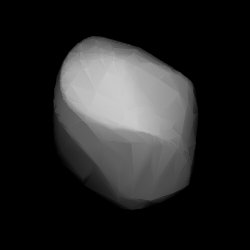 Modelled shape of Libera from its lightcurve | |
| Discovery [1] | |
|---|---|
| Discovered by | J. Rheden |
| Discovery site | Vienna Observatory |
| Discovery date | 21 November 1913 |
| Designations | |
| (771) Libera | |
| Pronunciation | Classically /ˈlɪbərə/ [2] |
Named after | friend of discoverer [3] |
| 1913 TO ·1958 HA | |
| main-belt ·(middle) [4] | |
| Orbital characteristics [1] | |
| Epoch 31 July 2016 (JD 2457600.5) | |
| Uncertainty parameter 0 | |
| Observation arc | 101.75 yr (37166 d) |
| Aphelion | 3.3092 AU (495.05 Gm) |
| Perihelion | 1.9937 AU (298.25 Gm) |
| 2.6514 AU (396.64 Gm) | |
| Eccentricity | 0.24808 |
| 4.32 yr (1576.9 d) | |
| 268.14° | |
| 0° 13m 41.844s / day | |
| Inclination | 14.936° |
| 218.19° | |
| 227.36° | |
| Earth MOID | 1.03684 AU (155.109 Gm) |
| Jupiter MOID | 2.11238 AU (316.008 Gm) |
| TJupiter | 3.299 |
| Physical characteristics | |
| Dimensions | 29.38±1.1 km (IRAS:6) [1] [5] 28.91±0.72 km [6] 29.000±1.403 km [7] 29.33 km (derived) [4] |
| 14.69±0.55 km | |
| 5.892±0.002 h [8] 5.92 h [9] 5.886±0.001 h [10] 5.89±0.05 h [10] 5.890±0.001 h [11] 5.892 h (0.2455 d) [1] | |
| 0.1303±0.010(IRAS:6) [1] [5] 0.141±0.008 [6] 0.1299±0.0158 [7] 0.1226 (SIMPS) [4] | |
| B–V = 0.687 U–B = 0.300 X (Tholen), X (SMASS), X [4] | |
| 10.49 [1] | |
771 Libera, provisional designation 1913 TO, is a metallic asteroid from the middle region of the asteroid belt, about 29 kilometers in diameter. It was discovered by Austrian astronomer Joseph Rheden at the Vienna Observatory in Austria, on 21 November 1913. [12]
